Hello Spring! Thank you for longer days to play outside and enjoy the fresh air. In addition to warmer weather, many of us are excited to get into our gardens, dig in the fresh dirt, plant new flowers and shrubs, and watch the greens and colors pop out of their slumber to celebrate the sun and warmer weather.
In addition to the joy of gardening, most of us also experience aches and pains in our bodies after time spent digging, mulching, planting, weeding, and harvesting. These tasks can result in sore muscles, achy backs, and creaky joints. The way we move our bodies while gardening is not usually ergonomically good and the effects of a few hours of work can be felt for days. When we move our bodies in different ways while gardening, we can avoid repetitive motion. Gardening without a variety of movements, will cause wear and tear on muscles, making them fatigue faster and become more prone to injury.
Yoga and gardening are a natural combination. When you garden, you plant a seed, nurture its growth, and experience its beautiful expression in full bloom. This is like a yoga practice. When you practice yoga, you set an intention, nurture your practice, and experience your true Self as an expression of the creative life force. “Gardening, like yoga, pulls us into that relationship of being connected to all things,” says Veronica D’Orazio, a yoga teacher in Seattle and the author of Gardener’s Yoga. “People garden for that timeless connection.”
You can incorporate the following poses as needed into your garden time or all together before or after gardening. Practice these moves outside in your garden and breathe in the fresh air while enjoying the fruits of your labor.
You can use common garden tools as props to help assist, stabilize, and open up your muscles and joints. Enjoy the rituals of rejuvenation for the mind, body, and spirit while connecting to Mother Nature and our sacred Earth.

Getting Started
A session in the garden can definitely feel like a full-body workout. A little mindfulness in how you move—and how you care for your body afterward—can go a long way to make you feel strong and limber enough to continue your work throughout the season.
To begin your yoga session after spending time in the garden, find a place on your land where you can stretch and reflect peacefully for 15-30 minutes. On a mat or blanket, take a seated position that is different from how you might sit in the garden. For example, if you normally sit on your knees, take a cross-legged position, or if you typically squat, sit with your knees together. Then close your eyes and begin to breathe. Think about the work you’ve done and the progress you made in your garden.
Hold each of the following poses for 5-8 breaths.
1. Cat/Cow & Shoulder/Hip Circles (spinal mobility)
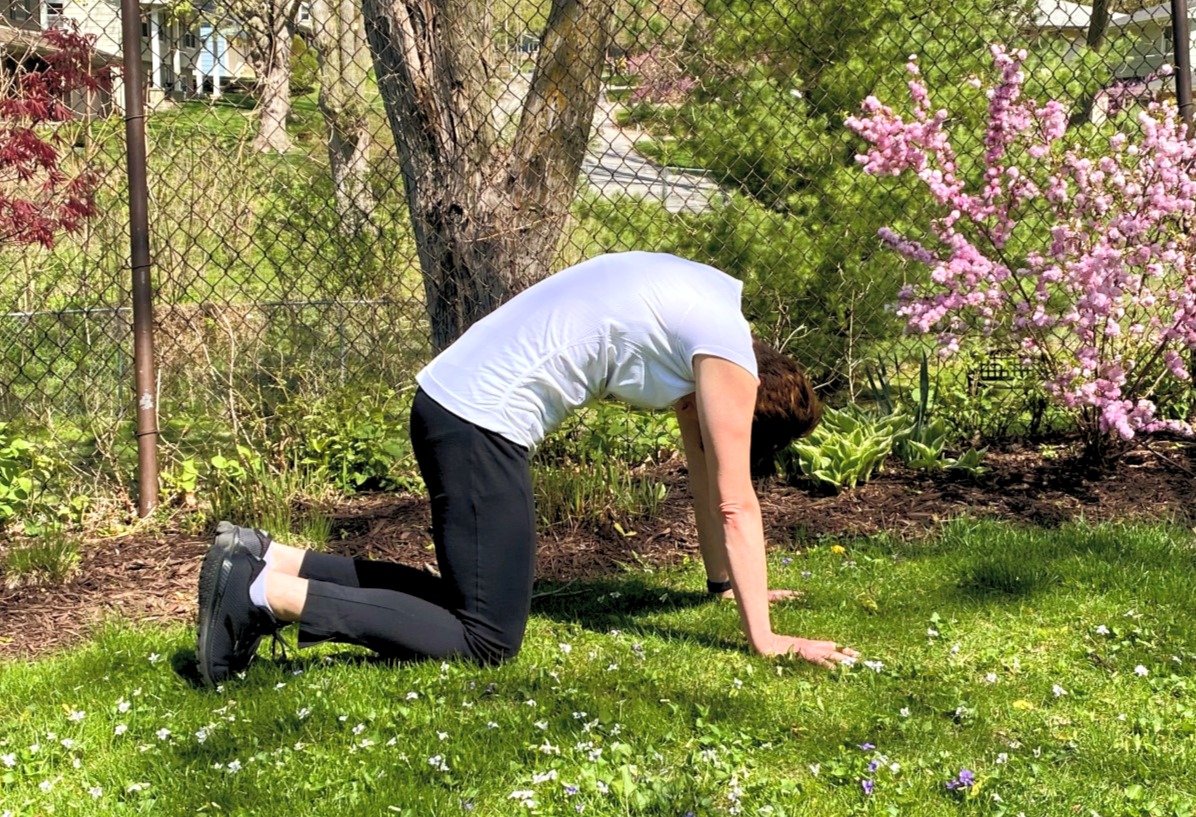
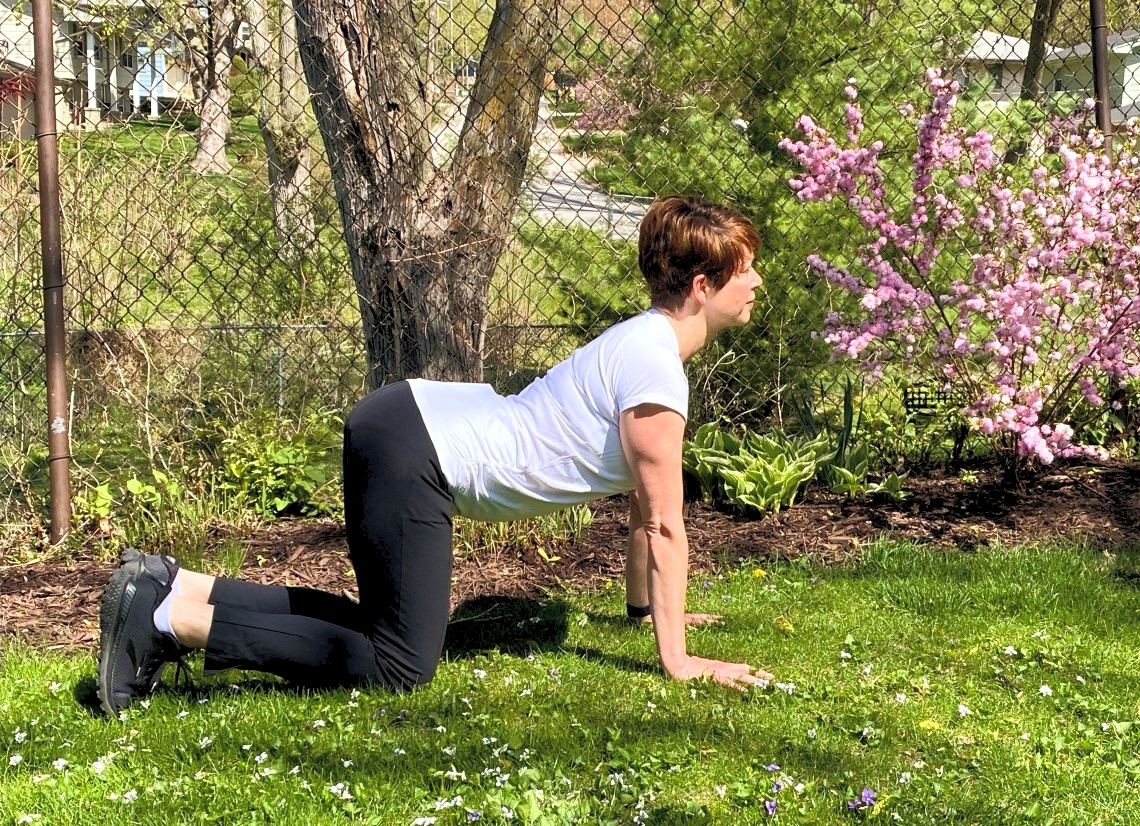
This is the classic spinal warm-up.
Arch your lower back and send your chest forward on an inhale. Round your back, tuck your chin, and expand through your ribs and spine as you exhale.
Continue this undulation of your spine in unison with your inhale and exhale until you feel sufficiently loosened through your spine.
You may also hold the extension and flexion of your spine and breathe deeply into each pose, using your breath to open space between your vertebrae.
2. Downward Facing Dog
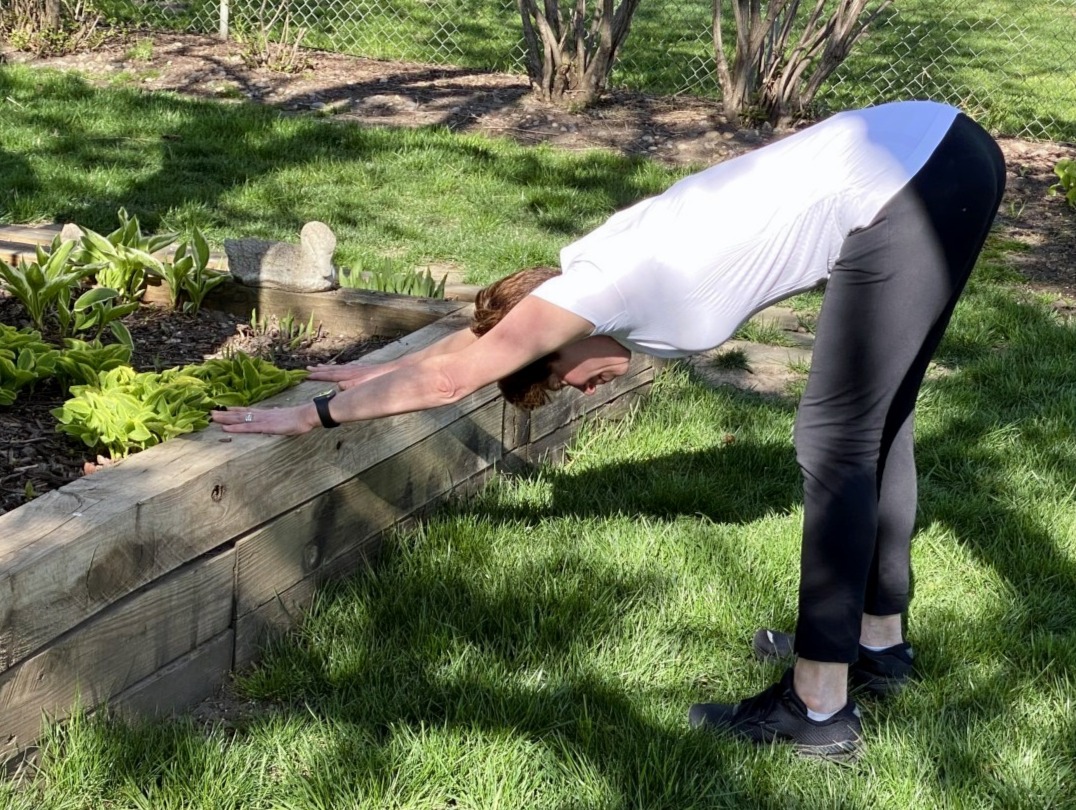
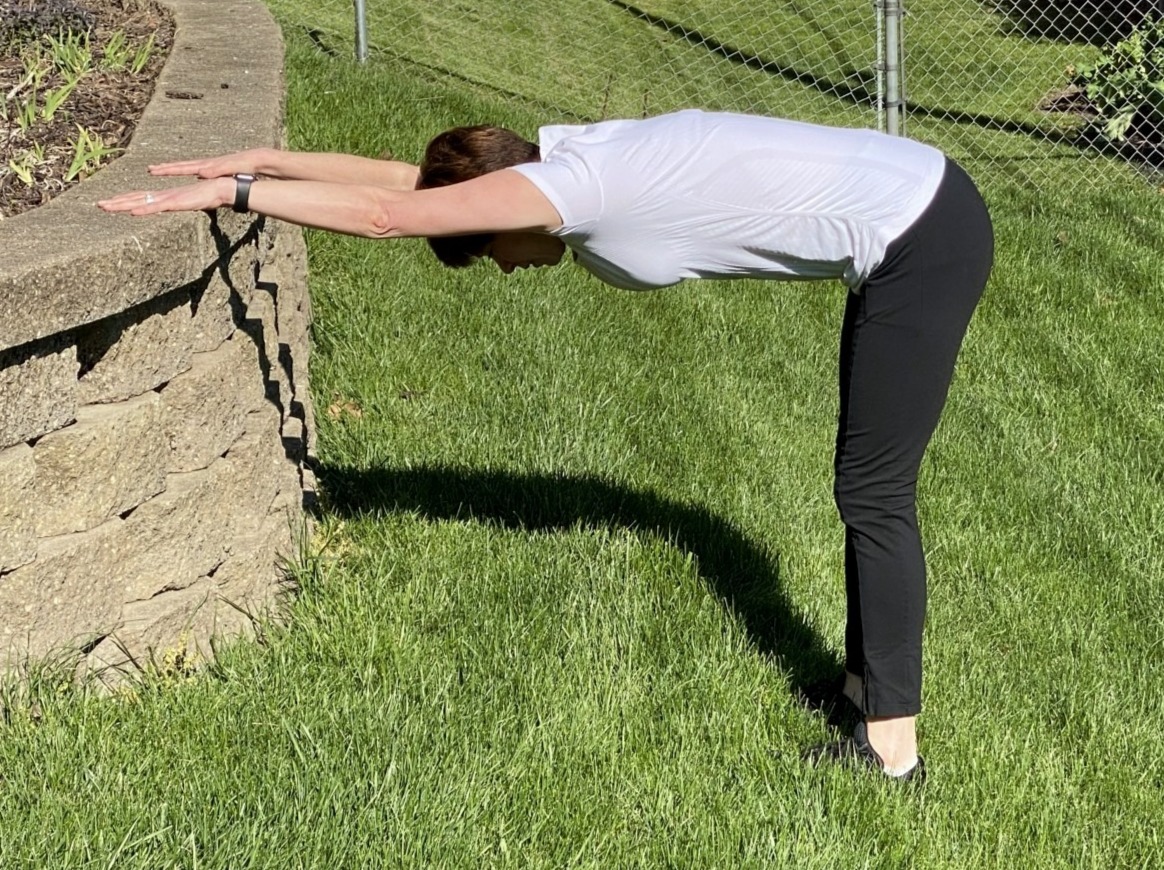
Press your palms firmly on a raised surface, like a terraced wall or deck step. Lift through your inner shoulder and extend through your arms, walking your feet back until they are under your hips with your heels pressed firmly into the ground.
Allow your head to move gently from side to side, releasing tension from your neck.
Lengthen through your spine, pressing your thighs back. Keep your belly engaged towards your spine and your shoulder blades drawing together on your back. Knees can be bent to relieve tension in the lower back. Slowly straighten the legs as flexibility increases.
Inhale fully to come back to upright as you walk your feet forward standing tall.
3. Standing Thigh Stretch
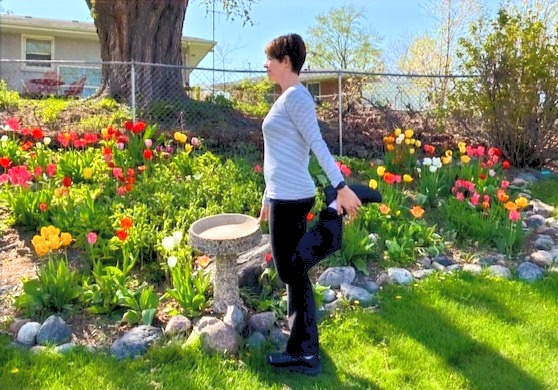
Begin standing and place yourself close to a support (e.g., birdbath, gate, tree).
Bend a knee and grab your foot or ankle. Press your hips and thigh forward.
Lengthen through the front of your leg as you stand tall, rolling your shoulders back to open the chest. Release the foot and switch sides.
4. Forward Fold (hamstring stretch)

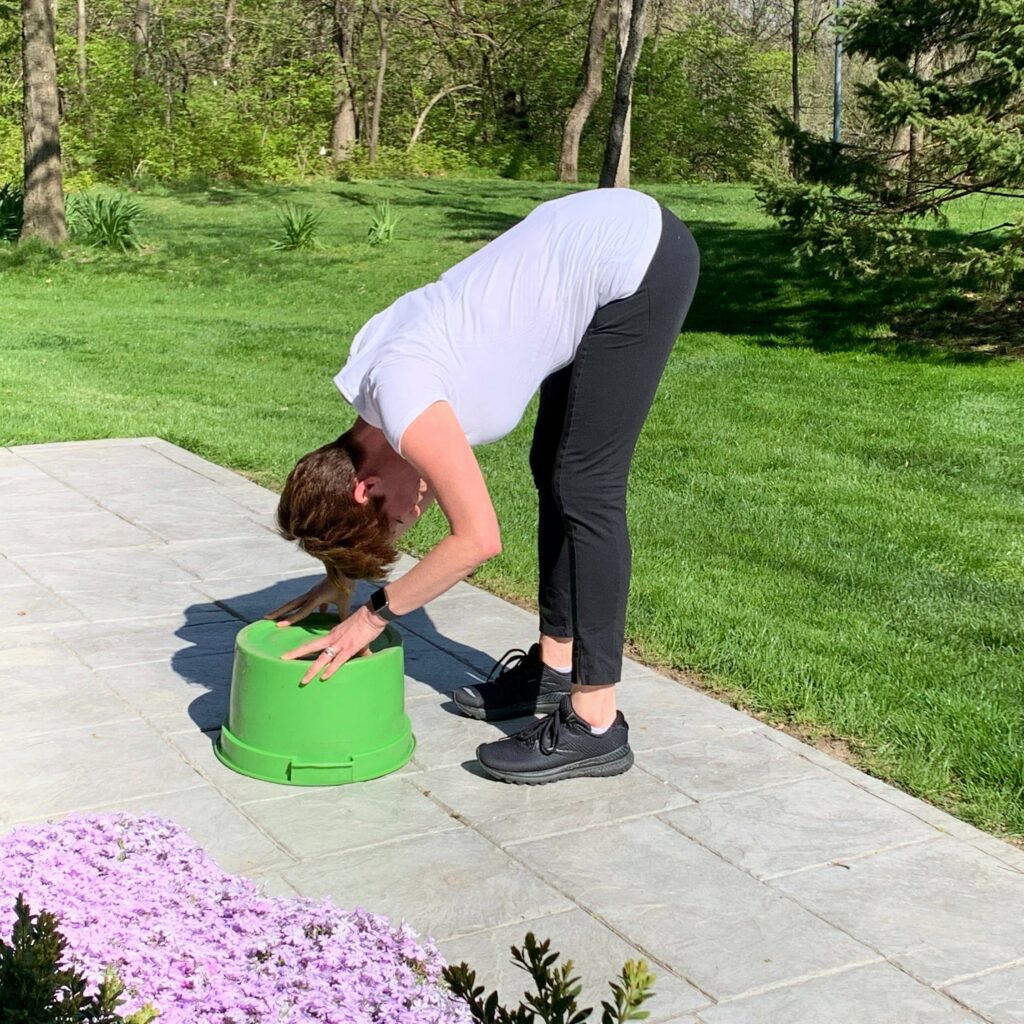
Place your feet hip-width apart. On an exhale, fold forward at your hips lengthening your spine.
Bend your knees as much as needed to feel a sense of ease in your lower back.
Place your hands on the floor or modify with your hand on a bucket upside down.
Relax your head and neck, lifting your shoulder blades up your back toward your hips.
Put weight into your heels, pressing your thighs back until you feel a stretch.
Inhale to come up lengthening through your spine.
5. Cactus Arms (chest stretch)
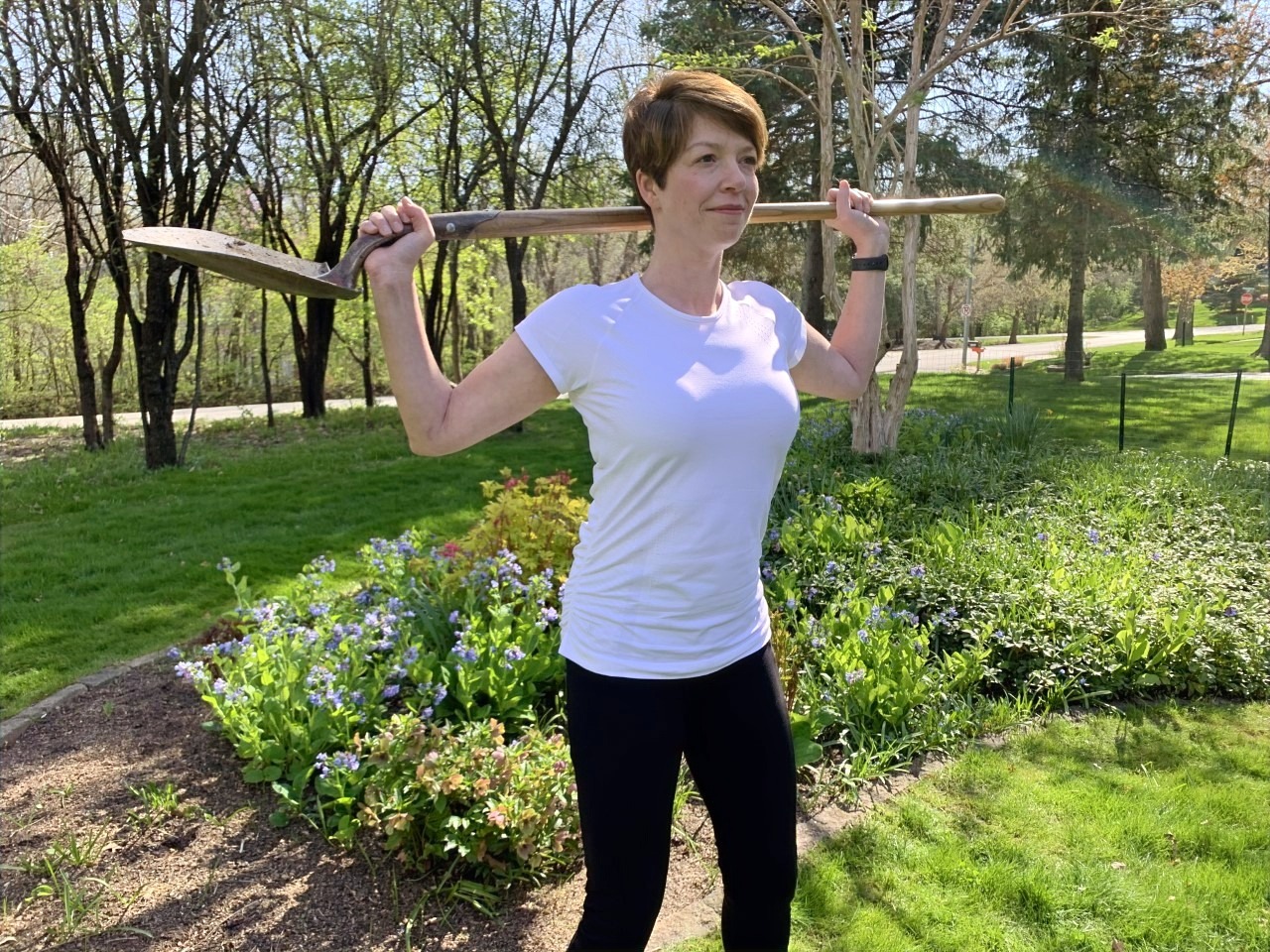
Standing upright with your feet hip-width apart, inhale your arms overhead and exhale while you bend your elbows to a ninety-degree angle. This shape looks like cactus arms or a “W”.
Draw your shoulder blades towards each other and towards your spine. Keep this action in the scapula as you drop the shoulders away from your ears.
This pose is helpful for counterbalancing all the forward-leaning and shoulder rounding you do while weeding, hoeing, digging, etc.
You may also use a shovel in your hands (shown in the image above) to get a deep stretch across the front of your chest.
6. Gomukhasana Arms (shoulder stretch)
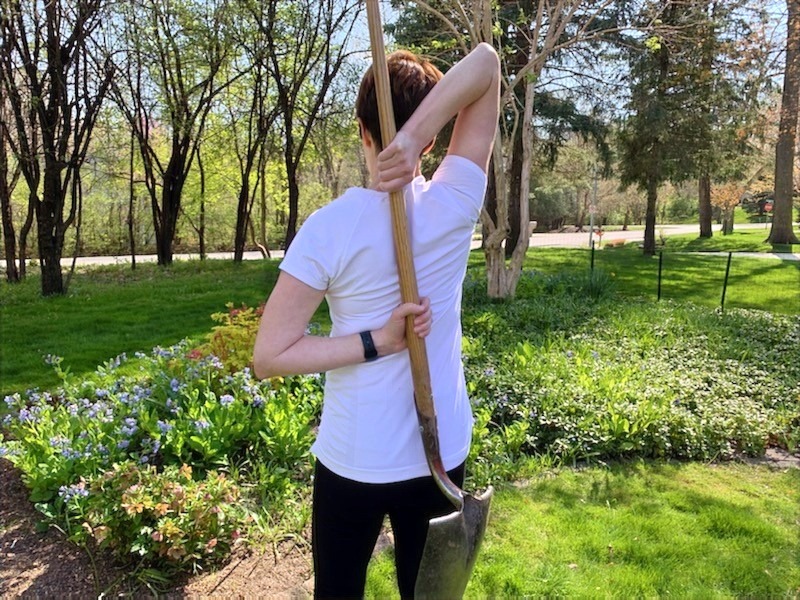
This funny Sanskrit name means “cow face”. The classical version is connecting your hands and opening up both shoulders. A modified version (shown in the image above) can be done using a shovel handle and gently easing your hands together.
On an inhale, lift your right arm up and bend your elbow, turning your upper arm in towards your head and placing your palm towards your back.
As you exhale, reach your left arm behind you with your palm facing out, bending your elbow once the hand meets your back. Slowly begin to walk your hands towards each other until they meet. You can use a garden tool, like a shovel, and focus on opening the shoulders and triceps.
From here, roll your left shoulder back and extend up through your right elbow. Hold this deep chest and shoulder opener for 5-10 breaths, releasing both arms on an exhale. Switch sides.
7. Butterfly Pose (inner thigh stretch)
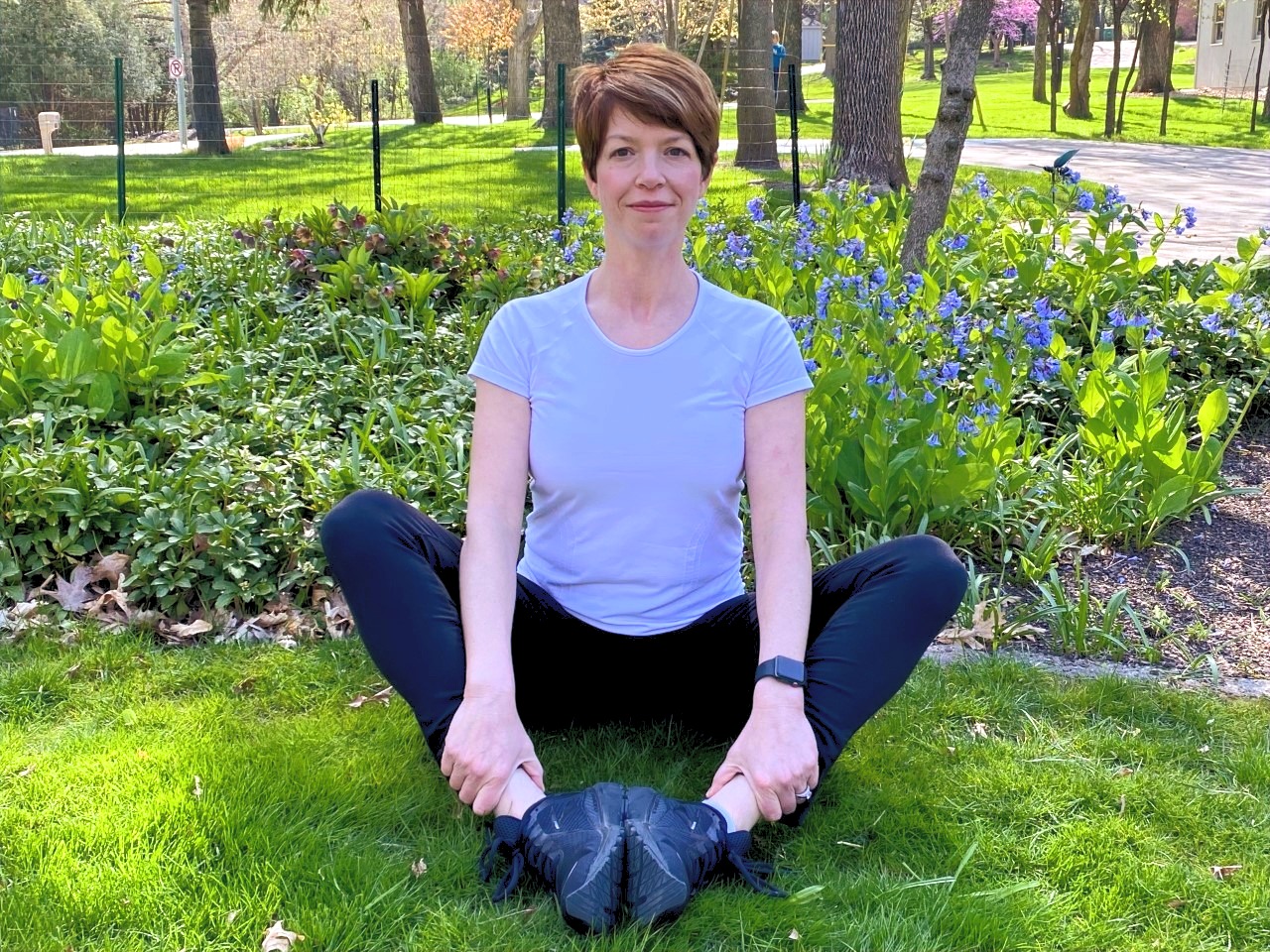
Begin in a seated position with feet together.
Place the feet a comfortable distance from the body opening the inner thighs.
Inhale the spine long and tall as you hold your feet or ankles. Exhale and hinge at the hips lengthening the spine forward and down. Hold the position when you feel a gentle stretch between your legs and across your lower back.
Inhale to come up.
8. Figure 4 (outer hip stretch)
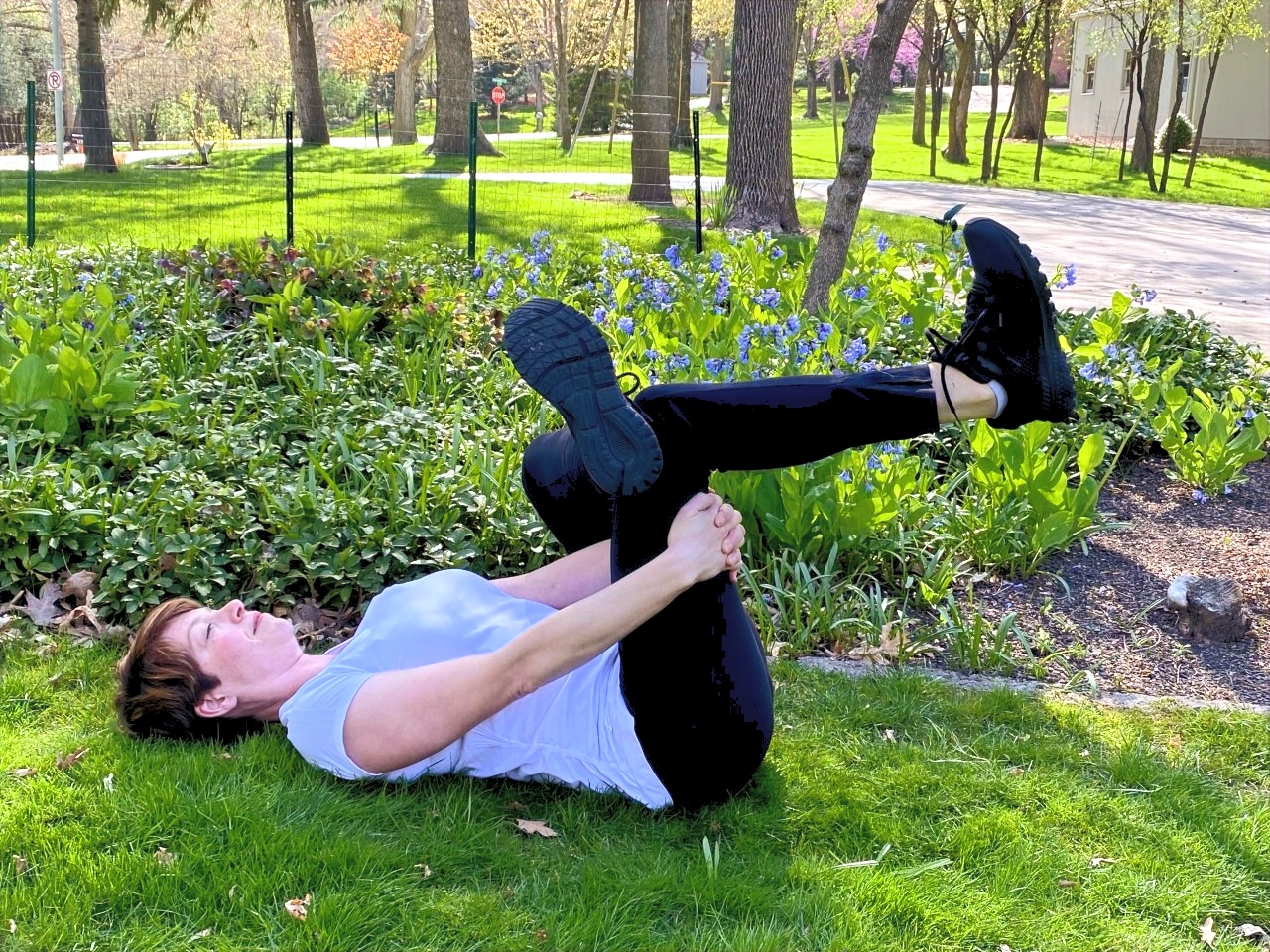
Lay on your back with your knees bent and your feet on the ground.
Cross your left ankle over your right knee. Press your left hand into the inner thigh to open up the hip. Hold this stretch for a few breaths.
If you would like a deeper stretch, keep your legs in the same position and exhale, bringing the lower body up towards your chest. Place your left hand between your legs to grab your right hand. Interlace your fingers on the back of your right thigh.
You can hold the stretch or rock the lower body side-to-side. Switch sides.
9. Bridge Pose

Begin on your back with your knees bent and feet hip-width apart.
Roll your shoulders back and towards each other to open up the chest.
On an inhale, bend your elbows 90 degrees to open your chest.
Exhale to lift your hips up toward the sky. Look up to the sky keeping your neck in a neutral position. Interlace your hands behind your back (shown in the image above) for a deeper chest stretch.
Engage the back of your legs by pressing the heels into the ground. Lift your chest towards your chin.
Stay for a few breaths to engage your back counterbalancing the forward-bending and shoulder rounding.
10. Supine Twist (lower back stretch)
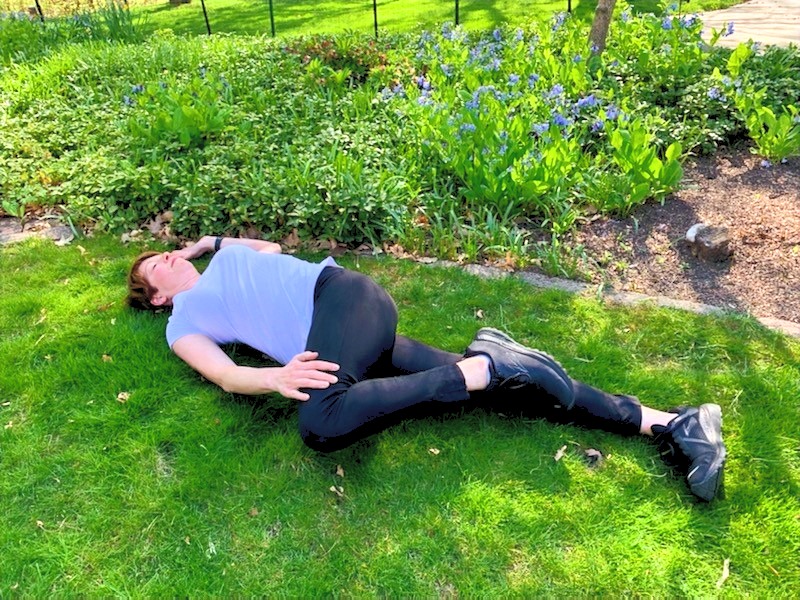
Lay on your back with your legs fully extended and your arms extended out to the sides.
On an inhale, draw your left knee up to your chest. On an exhale, hold the knee with your right hand and slowly move the knee across your body until you feel a stretch in your lower back and outer hip.
Keep your shoulders on the ground as you move into the twist.
Rest your foot on the extended leg or ground. Turn the head away from the knee for a deeper twist or look up at the sky.
Draw your knees back to center with an inhale. Hug both knees into the chest and rock side-to-side before switching sides.
Relax
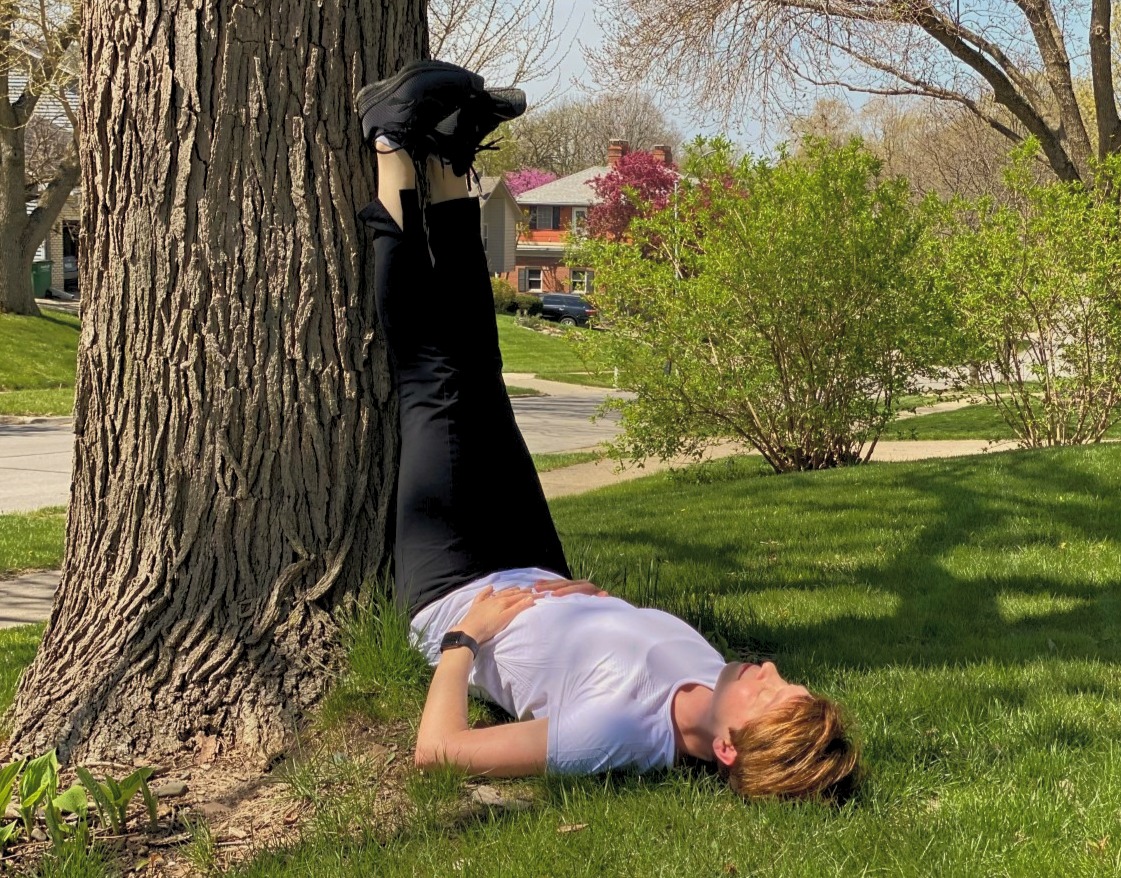
For your final resting pose, you can rest flat on the ground with your legs extended and your arms by your side. Or you can move into an inversion to reverse the circulation in your body, which helps with leg fatigue and circulates good blood to your organs and brain.
To move into a supportive inversion, extend your legs straight up against a wall or tree with your bottom on the ground or rest your calves on the seat of a bench or chair. Feel your back flat against the Earth.
You can do anything with your arms—rest them by your side, stretch them above your head, or place your hands on your belly.
Enjoy this time to relax, stretch, and unwind from your time in the garden. When your body feels good, you can better appreciate all the garden has to offer.
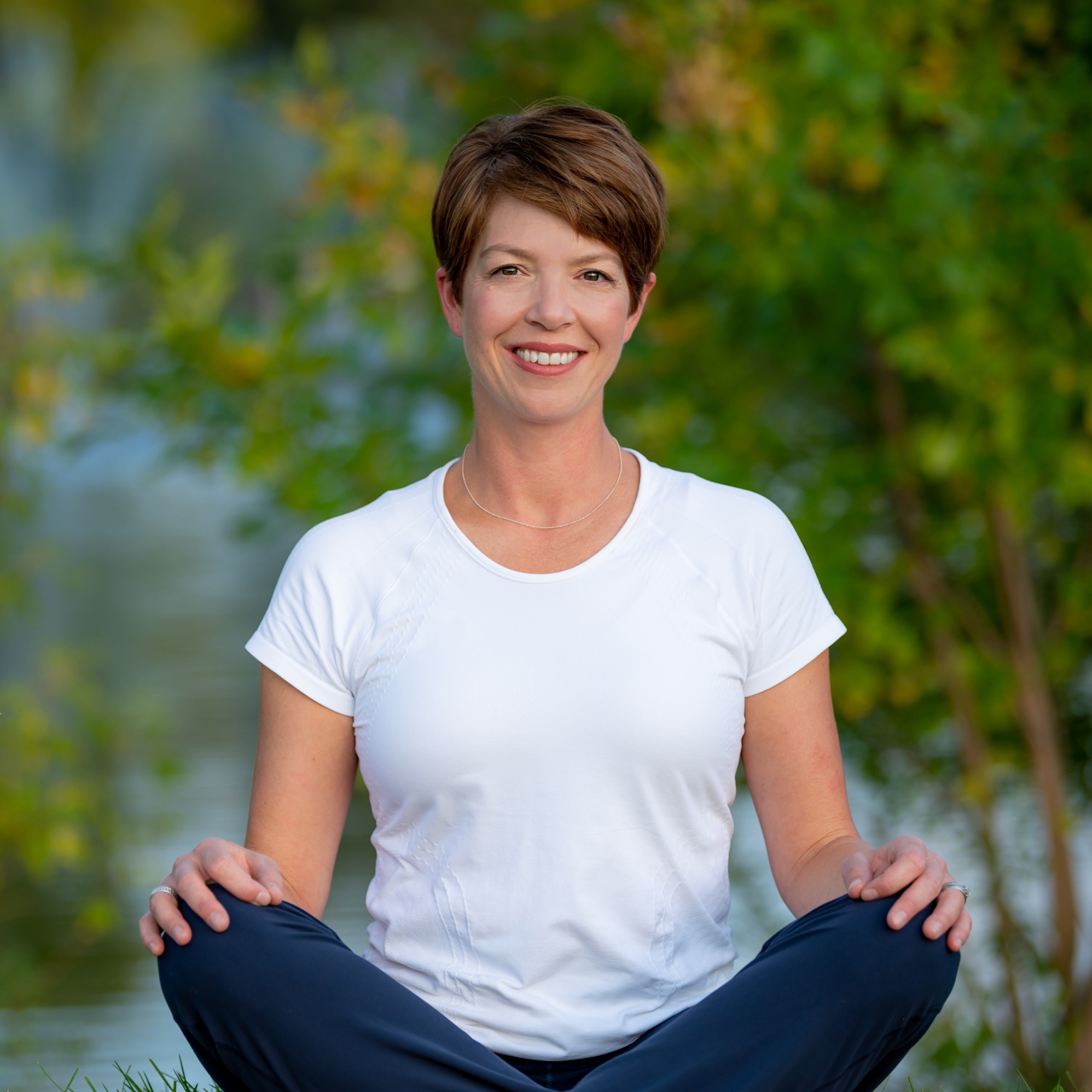
Mary McCarthy, MPH, is the owner of “Resilience & Grace.” She is an E-500 RYT yoga instructor. With over 20 years of experience teaching, Mary shares her passion and knowledge of yoga with people of all ages helping them feel good at any age. You can practice with Mary online at www.mary-mccarthy.com and follow her on Facebook and Instagram @yogabymary.
Watch Mary’s “Yoga for Gardeners” Wellness Wednesday segment on Hello Iowa.

